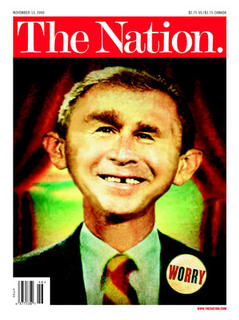
Let's summarize what the Bush administration knew during the months leading up to 9/11.
From the 9/11 Commission Report, Chapter Eight,
'The System Was Blinking Red'
During 2001, Director of Central Intelligence GeorgeTenet was briefed regularly regarding threats and other operational information relating to Usama Bin Ladin. He in turn met daily with President Bush, who was briefed by the CIA through what is known as the President's Daily Brief (PDB).
There were more than 40 intelligence articles in the PDBs from January 20 to September 10, 2001, that related to Bin Ladin.
The Drumbeat Begins
In the spring of 2001, the level of reporting on terrorist threats and planned attacks increased dramatically to its highest level since the millennium alert.
On March 23, in connection with discussions about possibly reopening Pennsylvania Avenue in front of the White House, Clarke warned National Security Advisor Condoleezza Rice that domestic or foreign terrorists might use a truck bomb-their "weapon of choice"-on Pennsylvania Avenue.
He (Clarke) also told her (Rice) that he thought there were terrorist cells within the United States, including al Qaeda. The next week, Rice was briefed on the activities of Abu Zubaydah and on CIA efforts to locate him.
Over the next few weeks,the CIA repeatedly issued warnings-including calls from DCI Tenet to Clarke-that Abu Zubaydah was planning an operation in the near future.One report cited a source indicating that Abu Zubaydah was planning an attack in a country that CIA analysts thought might be Israel, or perhaps Saudi Arabia or India. Clarke relayed these reports to Rice. In response to these threats, the FBI sent a message to all its field offices on April 13, 2001.
The next day, (April 20, 2001) a briefing to top officials reported "Bin Ladin planning multiple operations." When the deputies discussed al Qaeda policy on April 30, they began with a briefing on the threat.
In May 2001, the drumbeat of reporting grew louder with reports to top officials that "Bin Ladin public profile may presage attack"and "Bin Ladin network's plans advancing." In early May, a walk-in to the FBI claimed there was a plan to launch attacks on London, Boston, and NewYork.Attorney General John Ashcroft was briefed by the CIA on May 15 regarding al Qaeda generally and the current threat reporting specifically.
The next day (May 16,2001) brought a report that a phone call to a U.S. embassy had warned that Bin Ladin supporters were planning an attack in the United States using "high explosives."
On May 17, based on the previous day's report, the first item on the CSG's agenda was "UBL: Operation Planned in U.S." The anonymous caller's tip could not be corroborated.
Late May brought reports of a possible hostage plot against Americans abroad to force the release of prisoners, including Sheikh Omar Abdel Rahman, the "Blind Sheikh," who was serving a life sentence for his role in the 1993 plot to blow up sites in NewYork City. The reporting noted that operatives might opt to hijack an aircraft or storm a U.S. embassy.
Reports similar to many of these were made available to President Bush in morning intelligence briefings with DCI Tenet, usually attended by Vice President Dick Cheney and National Security Advisor Rice.
On May 29, Clarke suggested that Rice ask DCI Tenet what more the United States could do to stop Abu Zubaydah from launching"a series of major terrorist attacks,"
High Probability of Near-Term "Spectacular" Attacks
A June 12 , 2001 CIA report passing along biographical background information on several terrorists mentioned, in commenting on Khalid Sheikh Mohammed, that he was recruiting people to travel to the United States to meet with colleagues already there so that they might conduct terrorist attacks on Bin Ladin's behalf.
On June 22, 2001 the CIA notified all its station chiefs about intelligence suggesting a possible al Qaeda suicide attack on a U.S.target over the next few days. DCI Tenet asked that all U.S. ambassadors be briefed.
A terrorist threat advisory distributed in late June indicated a high probability of near-term "spectacular" terrorist attacks resulting in numerous casualties. Other reports' titles warned,"Bin Ladin Attacks May be Imminent" and "Bin Ladin and Associates Making Near-Term Threats."
On June 21,near the height of the threat reporting,U.S.Central Command raised the force protection condition level for U.S. troops in six countries to the highest possible level, Delta.The U.S. Fifth Fleet moved out of its port in Bahrain, and a U.S. Marine Corps exercise in Jordan was halted.
On June 25, 2001 Clarke warned Rice and Hadley that six separate intelligence reports showed al Qaeda personnel warning of a pending attack…
On June 28, Clarke wrote Rice that the pattern of al Qaeda activity indicating attack planning over the past six weeks "had reached a crescendo.""A series of new reports continue to convince me and analysts at State, CIA, DIA [Defense Intelligence Agency], and NSA that a major terrorist attack or series of attacks is likely in July…"
On July 2, the FBI Counterterrorism Division sent a message to federal agencies and state and local law enforcement agencies summarizing information regarding threats from Bin Ladin.
Clarke and others told us of a particular concern about possible attacks on the Fourth of July. After it passed uneventfully, the CSG decided to maintain the alert. To enlist more international help, Vice President Cheney contacted Saudi Crown Prince Abdullah on July 5.
On July 5, representatives from the Immigration and Naturalization Service (INS), the FAA, the Coast Guard, the Secret Service, Customs, the CIA, and the FBI met with Clarke to discuss the current threat.
That same day, the CIA briefed Attorney General Ashcroft on the al Qaeda threat, warning that a significant terrorist attack was imminent. Ashcroft was told that preparations for multiple attacks were in late stages or already complete and that little additional warning could be expected.
The next day, the CIA representative told the CSG that al Qaeda members believed the upcoming attack would be "spectacular," qualitatively different from anything they had done to date.
On July 9, when 37 officials from 27 agencies and organizations were briefed on the "current threat level" in the United States.
On July 23, the lead item for CSG discussion was still the al Qaeda threat,and it included mention of suspected terrorist travel to the United States.
Tenet told us that in his world "the system was blinking red." By late July, Tenet said, it could not "get any worse."
On June 30, the SEIB contained an article titled "Bin Ladin Threats Are Real." Yet Hadley told Tenet in July that Deputy Secretary of Defense PaulWolfowitz questioned the reporting.
On July 27, Clarke informed Rice and Hadley that the spike in intelligence about a near-term al Qaeda attack had stopped. He urged keeping readiness high during the August vacation period,warning that another report suggested an attack had just been postponed for a few months "but will still happen."
On August 3, the intelligence community issued an advisory concluding that the threat of impending al Qaeda attacks would likely continue indefinitely.
Two CIA analysts involved in preparing this briefing article believed it represented an opportunity to communicate their view that the threat of a Bin Ladin attack in the United States remained both current and serious.35 The result was an article in the August 6 Presidential Daily Brief titled "Bin Ladin Determined to Strike in US." It was the 36th PDB item briefed so far that year that related to Bin Ladin or al Qaeda, and the first devoted to the possibility of an attack in the United States. The President told us the August 6 report was historical in nature.President Bush said the article told him that al Qaeda was dangerous, which he said he had known since he had become President.
DCI Tenet visited President Bush in Crawford,Texas, on August 17 and participated in PDB briefings of the President between August 31 (after the President had returned to Washington) and September 10.
Once again, Bush was vacationing in Crawford-
This information comes from Chapter 8, of the 9/11 Commission's Report, titled, 'The System was Blinking Red'. For those of you who are interested in knowing the truth-read it. For those of you who have no interest in knowing the truth-watch Fox News.





